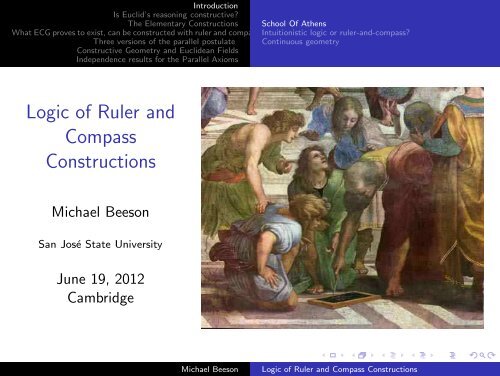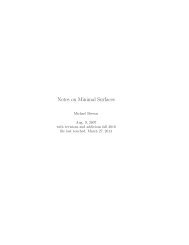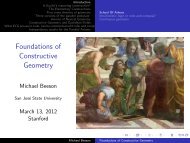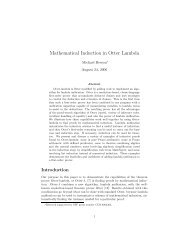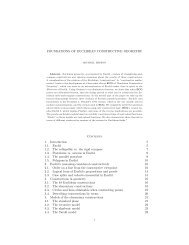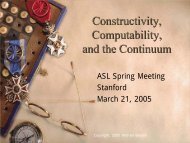Logic of Ruler and Compass Constructions - Michael Beeson's ...
Logic of Ruler and Compass Constructions - Michael Beeson's ...
Logic of Ruler and Compass Constructions - Michael Beeson's ...
You also want an ePaper? Increase the reach of your titles
YUMPU automatically turns print PDFs into web optimized ePapers that Google loves.
Introduction<br />
Is Euclid’s reasoning constructive?<br />
The Elementary <strong>Constructions</strong><br />
What ECG proves to exist, can be constructed with ruler <strong>and</strong> compass<br />
Three versions <strong>of</strong> the parallel postulate<br />
Constructive Geometry <strong>and</strong> Euclidean Fields<br />
Independence results for the Parallel Axioms<br />
School Of Athens<br />
Intuitionistic logic or ruler-<strong>and</strong>-compass?<br />
Continuous geometry<br />
<strong>Logic</strong> <strong>of</strong> <strong>Ruler</strong> <strong>and</strong><br />
<strong>Compass</strong><br />
<strong>Constructions</strong><br />
<strong>Michael</strong> Beeson<br />
San José State University<br />
June 19, 2012<br />
Cambridge<br />
<strong>Michael</strong> Beeson<br />
<strong>Logic</strong> <strong>of</strong> <strong>Ruler</strong> <strong>and</strong> <strong>Compass</strong> <strong>Constructions</strong>
Introduction<br />
Is Euclid’s reasoning constructive?<br />
The Elementary <strong>Constructions</strong><br />
What ECG proves to exist, can be constructed with ruler <strong>and</strong> compass<br />
Three versions <strong>of</strong> the parallel postulate<br />
Constructive Geometry <strong>and</strong> Euclidean Fields<br />
Independence results for the Parallel Axioms<br />
Euclidean Constructive Geometry ECG<br />
School Of Athens<br />
Intuitionistic logic or ruler-<strong>and</strong>-compass?<br />
Continuous geometry<br />
Does constructive refer to the use <strong>of</strong> intuitionistic logic?<br />
Or does it refer to geometrical constructions with ruler <strong>and</strong><br />
compass?<br />
What is the relation between these two?<br />
In our constructive geometry, they are closely related: things<br />
proved to exist can be constructed with ruler <strong>and</strong> compass.<br />
<strong>Michael</strong> Beeson<br />
<strong>Logic</strong> <strong>of</strong> <strong>Ruler</strong> <strong>and</strong> <strong>Compass</strong> <strong>Constructions</strong>
Introduction<br />
Is Euclid’s reasoning constructive?<br />
The Elementary <strong>Constructions</strong><br />
What ECG proves to exist, can be constructed with ruler <strong>and</strong> compass<br />
Three versions <strong>of</strong> the parallel postulate<br />
Constructive Geometry <strong>and</strong> Euclidean Fields<br />
Independence results for the Parallel Axioms<br />
Continuous geometry<br />
School Of Athens<br />
Intuitionistic logic or ruler-<strong>and</strong>-compass?<br />
Continuous geometry<br />
Constructive pro<strong>of</strong>s yield continuity in parameters.<br />
In practice, constructive pro<strong>of</strong>s require continuity in parameters.<br />
There are thus three ways <strong>of</strong> looking at this subject: geometry with<br />
intuitionistic logic, geometry <strong>of</strong> ruler-<strong>and</strong>-compass constructions,<br />
geometry with continuous dependence on parameters.<br />
<strong>Michael</strong> Beeson<br />
<strong>Logic</strong> <strong>of</strong> <strong>Ruler</strong> <strong>and</strong> <strong>Compass</strong> <strong>Constructions</strong>
Introduction<br />
Is Euclid’s reasoning constructive?<br />
The Elementary <strong>Constructions</strong><br />
What ECG proves to exist, can be constructed with ruler <strong>and</strong> compass<br />
Three versions <strong>of</strong> the parallel postulate<br />
Constructive Geometry <strong>and</strong> Euclidean Fields<br />
Independence results for the Parallel Axioms<br />
Is Euclid’s reasoning constructive?<br />
Yes, Euclid’s reasoning is generally constructive; indeed the only<br />
irreparably non-constructive proposition is Book I, Prop. 2, which<br />
shows that a rigid compass can be simulated by a collapsible<br />
compass. We just take Euclid I.2 as an axiom, thus requiring a<br />
rigid compass in ECG. Only one other repair is needed, in the<br />
formulation <strong>of</strong> the parallel axiom, as we shall see below.<br />
We also take as an axiom ¬¬B(x,y,z) → B(x,y,z), or<br />
“Markov’s principle for betweenness”, enabling us to drop double<br />
negations on atomic sentences. Here betweenness is strict.<br />
<strong>Michael</strong> Beeson<br />
<strong>Logic</strong> <strong>of</strong> <strong>Ruler</strong> <strong>and</strong> <strong>Compass</strong> <strong>Constructions</strong>
Introduction<br />
Is Euclid’s reasoning constructive?<br />
The Elementary <strong>Constructions</strong><br />
What ECG proves to exist, can be constructed with ruler <strong>and</strong> compass<br />
Three versions <strong>of</strong> the parallel postulate<br />
Constructive Geometry <strong>and</strong> Euclidean Fields<br />
Independence results for the Parallel Axioms<br />
The Elementary <strong>Constructions</strong><br />
Models <strong>of</strong> the Elementary <strong>Constructions</strong><br />
◮ Line (A,B)<br />
◮ Circle (A,B) (center A, passes through B) collapsible compass<br />
◮ Circle (A,B,C) (center A, radius BC) rigid compass<br />
<strong>Michael</strong> Beeson<br />
<strong>Logic</strong> <strong>of</strong> <strong>Ruler</strong> <strong>and</strong> <strong>Compass</strong> <strong>Constructions</strong>
Introduction<br />
Is Euclid’s reasoning constructive?<br />
The Elementary <strong>Constructions</strong><br />
What ECG proves to exist, can be constructed with ruler <strong>and</strong> compass<br />
Three versions <strong>of</strong> the parallel postulate<br />
Constructive Geometry <strong>and</strong> Euclidean Fields<br />
Independence results for the Parallel Axioms<br />
The Elementary <strong>Constructions</strong><br />
Models <strong>of</strong> the Elementary <strong>Constructions</strong><br />
◮ Line (A,B)<br />
◮ Circle (A,B) (center A, passes through B) collapsible compass<br />
◮ Circle (A,B,C) (center A, radius BC) rigid compass<br />
◮ IntersectLines (A,B,C,D) (AB meets CD)<br />
<strong>Michael</strong> Beeson<br />
<strong>Logic</strong> <strong>of</strong> <strong>Ruler</strong> <strong>and</strong> <strong>Compass</strong> <strong>Constructions</strong>
Introduction<br />
Is Euclid’s reasoning constructive?<br />
The Elementary <strong>Constructions</strong><br />
What ECG proves to exist, can be constructed with ruler <strong>and</strong> compass<br />
Three versions <strong>of</strong> the parallel postulate<br />
Constructive Geometry <strong>and</strong> Euclidean Fields<br />
Independence results for the Parallel Axioms<br />
The Elementary <strong>Constructions</strong><br />
Models <strong>of</strong> the Elementary <strong>Constructions</strong><br />
◮ Line (A,B)<br />
◮ Circle (A,B) (center A, passes through B) collapsible compass<br />
◮ Circle (A,B,C) (center A, radius BC)<br />
◮ IntersectLines (A,B,C,D) (AB meets CD)<br />
rigid compass<br />
◮ IntersectLineCircle1 (A,B,C,D)<br />
(Line AB meets circle with center C through D)<br />
◮ IntersectLineCircle2 (A,B,C,D)<br />
<strong>Michael</strong> Beeson<br />
<strong>Logic</strong> <strong>of</strong> <strong>Ruler</strong> <strong>and</strong> <strong>Compass</strong> <strong>Constructions</strong>
Introduction<br />
Is Euclid’s reasoning constructive?<br />
The Elementary <strong>Constructions</strong><br />
What ECG proves to exist, can be constructed with ruler <strong>and</strong> compass<br />
Three versions <strong>of</strong> the parallel postulate<br />
Constructive Geometry <strong>and</strong> Euclidean Fields<br />
Independence results for the Parallel Axioms<br />
The Elementary <strong>Constructions</strong><br />
Models <strong>of</strong> the Elementary <strong>Constructions</strong><br />
◮ Line (A,B)<br />
◮ Circle (A,B) (center A, passes through B) collapsible compass<br />
◮ Circle (A,B,C) (center A, radius BC)<br />
◮ IntersectLines (A,B,C,D) (AB meets CD)<br />
rigid compass<br />
◮ IntersectLineCircle1 (A,B,C,D)<br />
(Line AB meets circle with center C through D)<br />
◮ IntersectLineCircle2 (A,B,C,D)<br />
◮ IntersectCircles1 (c 1 ,c 2 )<br />
◮ IntersectCircles2 (c 1 ,c 2 )<br />
<strong>Michael</strong> Beeson<br />
<strong>Logic</strong> <strong>of</strong> <strong>Ruler</strong> <strong>and</strong> <strong>Compass</strong> <strong>Constructions</strong>
Introduction<br />
Is Euclid’s reasoning constructive?<br />
The Elementary <strong>Constructions</strong><br />
What ECG proves to exist, can be constructed with ruler <strong>and</strong> compass<br />
Three versions <strong>of</strong> the parallel postulate<br />
Constructive Geometry <strong>and</strong> Euclidean Fields<br />
Independence results for the Parallel Axioms<br />
Models <strong>of</strong> the Elementary <strong>Constructions</strong><br />
Models <strong>of</strong> the Elementary <strong>Constructions</strong><br />
◮ The “st<strong>and</strong>ard plane” R 2<br />
◮ The “recursive plane”. Points are given by recursive functions<br />
giving rational approximations to within 1/n.<br />
◮ The minimal model, the points constructible by ruler <strong>and</strong><br />
compass<br />
◮ The algebraic plane, points with algebraic coordinates<br />
◮ The Poincaré model. These constructions work in<br />
non-Euclidean geometry too.<br />
<strong>Michael</strong> Beeson<br />
<strong>Logic</strong> <strong>of</strong> <strong>Ruler</strong> <strong>and</strong> <strong>Compass</strong> <strong>Constructions</strong>
Introduction<br />
Is Euclid’s reasoning constructive?<br />
The Elementary <strong>Constructions</strong><br />
What ECG proves to exist, can be constructed with ruler <strong>and</strong> compass<br />
Three versions <strong>of</strong> the parallel postulate<br />
Constructive Geometry <strong>and</strong> Euclidean Fields<br />
Independence results for the Parallel Axioms<br />
What ECG proves to exist, can be constructed with ruler<br />
<strong>and</strong> compass<br />
In earlier work I proved that if ECG proves an existential statement<br />
∃yA(x,y), with A negative, then there is a term t <strong>of</strong> ECG such<br />
that ECG proves A(x,t(x)). In words: things that ECG can prove<br />
to exist, can be constructed with ruler <strong>and</strong> compass. Of course,<br />
the converse is immediate: things that can be constructed with<br />
ruler <strong>and</strong> compass can be proved to exist in ECG. Hence the two<br />
meanings <strong>of</strong> “constructive” coincide for ECG: it could mean<br />
“proved to exist with intuitionistic logic” or it could mean<br />
“constructed with ruler <strong>and</strong> compass.”<br />
<strong>Michael</strong> Beeson<br />
<strong>Logic</strong> <strong>of</strong> <strong>Ruler</strong> <strong>and</strong> <strong>Compass</strong> <strong>Constructions</strong>
Introduction<br />
Is Euclid’s reasoning constructive?<br />
The Elementary <strong>Constructions</strong><br />
What ECG proves to exist, can be constructed with ruler <strong>and</strong> compass<br />
Three versions <strong>of</strong> the parallel postulate<br />
Constructive Geometry <strong>and</strong> Euclidean Fields<br />
Independence results for the Parallel Axioms<br />
Euclid’s Parallel Postulate<br />
Euclid 5<br />
Inadequacy <strong>of</strong> Euclid 5<br />
The Strong Parallel Postulate <strong>of</strong> ECG<br />
Playfair’s Axiom<br />
If a straight line falling on two straight lines make the interior<br />
angles on the same side less than two right angles, the two straight<br />
lines, if produced indefinitely, meet on that side on which are the<br />
angles less than the two right angles.<br />
That is, M <strong>and</strong> L must meet on the right side, provided B(q,a,r)<br />
<strong>and</strong> pq makes alternate interior angles equal with K <strong>and</strong> L. The<br />
point at the open circle is asserted to exist.<br />
M<br />
K<br />
p<br />
•<br />
•<br />
a<br />
r<br />
•<br />
L<br />
•<br />
q<br />
<strong>Michael</strong> Beeson<br />
<strong>Logic</strong> <strong>of</strong> <strong>Ruler</strong> <strong>and</strong> <strong>Compass</strong> <strong>Constructions</strong>
•<br />
Introduction<br />
Is Euclid’s reasoning constructive?<br />
The Elementary <strong>Constructions</strong><br />
What ECG proves to exist, can be constructed with ruler <strong>and</strong> compass<br />
Three versions <strong>of</strong> the parallel postulate<br />
Constructive Geometry <strong>and</strong> Euclidean Fields<br />
Independence results for the Parallel Axioms<br />
Euclid 5 without mentioning angles<br />
K<br />
Euclid 5<br />
Inadequacy <strong>of</strong> Euclid 5<br />
The Strong Parallel Postulate <strong>of</strong> ECG<br />
Playfair’s Axiom<br />
We need to eliminate mention <strong>of</strong> “alternate interior angles”,<br />
because angles are not directly treated in ECG, but instead are<br />
treated as triples <strong>of</strong> points.<br />
M <strong>and</strong> L must meet on the right side, provided B(q,a,r) <strong>and</strong><br />
pt = qt <strong>and</strong> rt = st.<br />
M<br />
p<br />
•<br />
r<br />
•<br />
L<br />
•<br />
s<br />
t<br />
•<br />
q<br />
•<br />
a<br />
<strong>Michael</strong> Beeson<br />
<strong>Logic</strong> <strong>of</strong> <strong>Ruler</strong> <strong>and</strong> <strong>Compass</strong> <strong>Constructions</strong>
Introduction<br />
Is Euclid’s reasoning constructive?<br />
The Elementary <strong>Constructions</strong><br />
What ECG proves to exist, can be constructed with ruler <strong>and</strong> compass<br />
Three versions <strong>of</strong> the parallel postulate<br />
Constructive Geometry <strong>and</strong> Euclidean Fields<br />
Independence results for the Parallel Axioms<br />
Inadequacy <strong>of</strong> Euclid 5<br />
Euclid 5<br />
Inadequacy <strong>of</strong> Euclid 5<br />
The Strong Parallel Postulate <strong>of</strong> ECG<br />
Playfair’s Axiom<br />
Although we have finally arrived at a satisfactory formulation <strong>of</strong><br />
Euclid 5, that formulation is satisfactory only in the sense that it<br />
accurately expresses what Euclid said. It turns out that this axiom<br />
is not satisfactory as a parallel postulate for ECG. The most<br />
obvious reason is that it is inadequate to define division<br />
geometrically. But it turns out to also be inadequate for<br />
continuous (constructive) addition <strong>and</strong> multiplication!<br />
<strong>Michael</strong> Beeson<br />
<strong>Logic</strong> <strong>of</strong> <strong>Ruler</strong> <strong>and</strong> <strong>Compass</strong> <strong>Constructions</strong>
Introduction<br />
Is Euclid’s reasoning constructive?<br />
The Elementary <strong>Constructions</strong><br />
What ECG proves to exist, can be constructed with ruler <strong>and</strong> compass<br />
Three versions <strong>of</strong> the parallel postulate<br />
Constructive Geometry <strong>and</strong> Euclidean Fields<br />
Independence results for the Parallel Axioms<br />
Division <strong>and</strong> parallels<br />
✬✩<br />
Euclid 5<br />
Inadequacy <strong>of</strong> Euclid 5<br />
The Strong Parallel Postulate <strong>of</strong> ECG<br />
Playfair’s Axiom<br />
−1/x<br />
❵❵❵❵❵❵❵❵❵❵❵❵ x ❵❵❵❵❵❵❵❵❵❵<br />
1/x<br />
✫✪<br />
The circle has radius 1. The slanted lines are parallel. 1/x is<br />
defined if <strong>and</strong> only if the horizontal line intersects the long slanted<br />
line. If we know the sign <strong>of</strong> x then Euclid 5 suffices; the vertical<br />
line is a transversal <strong>and</strong> on one side the interior angles are less than<br />
two right angles.<br />
<strong>Michael</strong> Beeson<br />
<strong>Logic</strong> <strong>of</strong> <strong>Ruler</strong> <strong>and</strong> <strong>Compass</strong> <strong>Constructions</strong>
Introduction<br />
Is Euclid’s reasoning constructive?<br />
The Elementary <strong>Constructions</strong><br />
What ECG proves to exist, can be constructed with ruler <strong>and</strong> compass<br />
Three versions <strong>of</strong> the parallel postulate<br />
Constructive Geometry <strong>and</strong> Euclidean Fields<br />
Independence results for the Parallel Axioms<br />
Division <strong>and</strong> parallels<br />
Euclid 5<br />
Inadequacy <strong>of</strong> Euclid 5<br />
The Strong Parallel Postulate <strong>of</strong> ECG<br />
Playfair’s Axiom<br />
Without knowing the sign <strong>of</strong> x, we will not know on which side <strong>of</strong><br />
the transversal pq the two adjacent interior angles will make less<br />
than two right angles. In other words, with Euclid 5, we will only<br />
be able to divide by a number whose sign we know; <strong>and</strong> the<br />
principle x ≠ 0 → x < 0 ∨ x > 0 is not an axiom (or theorem) <strong>of</strong><br />
ECG. The conclusion is that if we want to divide by nonzero<br />
numbers, we need to strengthen Euclid’s parallel axiom.<br />
<strong>Michael</strong> Beeson<br />
<strong>Logic</strong> <strong>of</strong> <strong>Ruler</strong> <strong>and</strong> <strong>Compass</strong> <strong>Constructions</strong>
•<br />
Introduction<br />
Is Euclid’s reasoning constructive?<br />
The Elementary <strong>Constructions</strong><br />
What ECG proves to exist, can be constructed with ruler <strong>and</strong> compass<br />
Three versions <strong>of</strong> the parallel postulate<br />
Constructive Geometry <strong>and</strong> Euclidean Fields<br />
Independence results for the Parallel Axioms<br />
The Strong Parallel Postulate <strong>of</strong> ECG<br />
Euclid 5<br />
Inadequacy <strong>of</strong> Euclid 5<br />
The Strong Parallel Postulate <strong>of</strong> ECG<br />
Playfair’s Axiom<br />
Figure: Strong Parallel Postulate: M <strong>and</strong> L must meet (somewhere)<br />
provided a is not on K <strong>and</strong> pt = qt <strong>and</strong> rt = st.<br />
K<br />
M<br />
p<br />
•<br />
r<br />
•<br />
L<br />
•<br />
s<br />
t<br />
•<br />
q<br />
•<br />
a<br />
<strong>Michael</strong> Beeson<br />
<strong>Logic</strong> <strong>of</strong> <strong>Ruler</strong> <strong>and</strong> <strong>Compass</strong> <strong>Constructions</strong>
Introduction<br />
Is Euclid’s reasoning constructive?<br />
The Elementary <strong>Constructions</strong><br />
What ECG proves to exist, can be constructed with ruler <strong>and</strong> compass<br />
Three versions <strong>of</strong> the parallel postulate<br />
Constructive Geometry <strong>and</strong> Euclidean Fields<br />
Independence results for the Parallel Axioms<br />
Euclid 5<br />
Inadequacy <strong>of</strong> Euclid 5<br />
The Strong Parallel Postulate <strong>of</strong> ECG<br />
Playfair’s Axiom<br />
Is the “strong” parallel axiom stronger than Euclid 5?<br />
The strong parallel axiom differs from Euclid’s version in that we<br />
are not required to know in what direction M passes through P;<br />
but also the conclusion is weaker, in that it does not specify where<br />
M must meet L. In other words, the betweenness hypothesis <strong>of</strong><br />
Euclid 5 is removed, <strong>and</strong> so is the betweenness conclusion. Since<br />
both the hypothesis <strong>and</strong> conclusion have been changed, it is not<br />
immediate whether this new postulate is stronger than Euclid 5, or<br />
equivalent, or possibly even weaker, but it turns out to be<br />
stronger–hence the name.<br />
<strong>Michael</strong> Beeson<br />
<strong>Logic</strong> <strong>of</strong> <strong>Ruler</strong> <strong>and</strong> <strong>Compass</strong> <strong>Constructions</strong>
Introduction<br />
Is Euclid’s reasoning constructive?<br />
The Elementary <strong>Constructions</strong><br />
What ECG proves to exist, can be constructed with ruler <strong>and</strong> compass<br />
Three versions <strong>of</strong> the parallel postulate<br />
Constructive Geometry <strong>and</strong> Euclidean Fields<br />
Independence results for the Parallel Axioms<br />
Playfair’s Axiom<br />
Euclid 5<br />
Inadequacy <strong>of</strong> Euclid 5<br />
The Strong Parallel Postulate <strong>of</strong> ECG<br />
Playfair’s Axiom<br />
Let P be a point not on line L. We consider lines through P that<br />
do not meet L (i.e., are parallel to L). Playfair’s version <strong>of</strong> the<br />
parallel postulate says that two parallels to L through P are equal.<br />
That is, in the picture not both M <strong>and</strong> K are parallel to L.<br />
But no point is asserted to exist.<br />
M<br />
K<br />
p<br />
•<br />
L<br />
<strong>Michael</strong> Beeson<br />
<strong>Logic</strong> <strong>of</strong> <strong>Ruler</strong> <strong>and</strong> <strong>Compass</strong> <strong>Constructions</strong>
Introduction<br />
Is Euclid’s reasoning constructive?<br />
The Elementary <strong>Constructions</strong><br />
What ECG proves to exist, can be constructed with ruler <strong>and</strong> compass<br />
Three versions <strong>of</strong> the parallel postulate<br />
Constructive Geometry <strong>and</strong> Euclidean Fields<br />
Independence results for the Parallel Axioms<br />
Euclidean rings<br />
Euclidean fields<br />
Classical Euclidean geometry has models K 2 = K × K where K is<br />
a Euclidean field, i.e. an ordered field in which nonnegative<br />
elements have square roots.<br />
We define a Euclidean ring to be an ordered ring in which<br />
nonnegative elements have square roots. We use a language with<br />
symbols + for addition <strong>and</strong> · for multiplication, <strong>and</strong> a unary<br />
predicate P(x) for “x is positive”.<br />
<strong>Michael</strong> Beeson<br />
<strong>Logic</strong> <strong>of</strong> <strong>Ruler</strong> <strong>and</strong> <strong>Compass</strong> <strong>Constructions</strong>
Introduction<br />
Is Euclid’s reasoning constructive?<br />
The Elementary <strong>Constructions</strong><br />
What ECG proves to exist, can be constructed with ruler <strong>and</strong> compass<br />
Three versions <strong>of</strong> the parallel postulate<br />
Constructive Geometry <strong>and</strong> Euclidean Fields<br />
Independence results for the Parallel Axioms<br />
Euclidean fields<br />
Euclidean fields<br />
Euclidean fields: nonzero elements have reciprocals.<br />
Weakly Euclidean fields: positive elements have reciprocals.<br />
Playfair rings: elements without reciprocals are zero, <strong>and</strong> if x is<br />
greater than a positive invertible element, then x is invertible.<br />
<strong>Michael</strong> Beeson<br />
<strong>Logic</strong> <strong>of</strong> <strong>Ruler</strong> <strong>and</strong> <strong>Compass</strong> <strong>Constructions</strong>
Introduction<br />
Is Euclid’s reasoning constructive?<br />
The Elementary <strong>Constructions</strong><br />
What ECG proves to exist, can be constructed with ruler <strong>and</strong> compass<br />
Three versions <strong>of</strong> the parallel postulate<br />
Constructive Geometry <strong>and</strong> Euclidean Fields<br />
Independence results for the Parallel Axioms<br />
Euclidean fields<br />
ECG corresponds to Euclidean fields<br />
The models <strong>of</strong> ECG are <strong>of</strong> the form F 2 , where F is a Euclidean<br />
field. More specifically, given such a field, we can define<br />
betweenness, incidence, <strong>and</strong> equidistance by analytic geometry <strong>and</strong><br />
verify the axioms <strong>of</strong> ECG. Conversely, <strong>and</strong> this is the hard part, we<br />
can define multiplication, addition, <strong>and</strong> division <strong>of</strong> points on a line<br />
(having chosen one point as zero), in ECG. It turns out that we<br />
need the strong parallel axiom to do that.<br />
We also need new constructions. Those <strong>of</strong> Descartes <strong>and</strong> Hilbert<br />
require case distinctions <strong>and</strong> do not provide continuous dependence<br />
on parameters.<br />
<strong>Michael</strong> Beeson<br />
<strong>Logic</strong> <strong>of</strong> <strong>Ruler</strong> <strong>and</strong> <strong>Compass</strong> <strong>Constructions</strong>
Introduction<br />
Is Euclid’s reasoning constructive?<br />
The Elementary <strong>Constructions</strong><br />
What ECG proves to exist, can be constructed with ruler <strong>and</strong> compass<br />
Three versions <strong>of</strong> the parallel postulate<br />
Constructive Geometry <strong>and</strong> Euclidean Fields<br />
Independence results for the Parallel Axioms<br />
Euclidean fields<br />
Weakly Euclidean fields correspond to Euclid 5<br />
If we replace the parallel axiom <strong>of</strong> ECG by Euclid’s parallel<br />
postulate, we get instead models <strong>of</strong> the form F 2 , where F is a<br />
weakly Euclidean field (that is, a Euclidean ring in which positive<br />
elements have reciprocals).<br />
We cannot go the other way by defining multiplication <strong>and</strong><br />
addition geometrically without the strong parallel axiom. (That is,<br />
if we only had Euclid 5, we would need case distinctions, as Hilbert<br />
<strong>and</strong> Descartes did.)<br />
<strong>Michael</strong> Beeson<br />
<strong>Logic</strong> <strong>of</strong> <strong>Ruler</strong> <strong>and</strong> <strong>Compass</strong> <strong>Constructions</strong>
Introduction<br />
Is Euclid’s reasoning constructive?<br />
The Elementary <strong>Constructions</strong><br />
What ECG proves to exist, can be constructed with ruler <strong>and</strong> compass<br />
Three versions <strong>of</strong> the parallel postulate<br />
Constructive Geometry <strong>and</strong> Euclidean Fields<br />
Independence results for the Parallel Axioms<br />
Euclidean fields<br />
Playfair rings correspond to Playfair’s axiom<br />
We now work out the field-theoretic version <strong>of</strong> Playfair’s axiom.<br />
Playfair says, if P is not on L <strong>and</strong> K is parallel to L through P,<br />
that if line M through P does not meet L then M = K. Since<br />
¬¬M = K → M = K, Playfair is just the contrapositive <strong>of</strong> the<br />
parallel axiom <strong>of</strong> ECG, which says that if M ≠ K then M meets<br />
L. Hence it corresponds to the contrapositive <strong>of</strong> x ≠ 0 → 1/x ↓;<br />
that contrapositive says that if x has no multiplicative inverse,<br />
then x = 0. Thus Playfair geometries have models F 2 where F is<br />
a Playfair ring (as defined above). (We cannot prove the converse<br />
because we need the strong parallel axiom to verify multiplication.)<br />
<strong>Michael</strong> Beeson<br />
<strong>Logic</strong> <strong>of</strong> <strong>Ruler</strong> <strong>and</strong> <strong>Compass</strong> <strong>Constructions</strong>
Introduction<br />
Is Euclid’s reasoning constructive?<br />
The Elementary <strong>Constructions</strong><br />
What ECG proves to exist, can be constructed with ruler <strong>and</strong> compass<br />
Three versions <strong>of</strong> the parallel postulate<br />
Constructive Geometry <strong>and</strong> Euclidean Fields<br />
Independence results for the Parallel Axioms<br />
Strong Parallel Axiom implies Euclid 5<br />
The reduction <strong>of</strong> geometry to field theory described above shows<br />
that (relative to a base theory), the strong parallel axiom implies<br />
Euclid’s postulate 5 (since if reciprocals <strong>of</strong> non-zero elements exist,<br />
then <strong>of</strong> course reciprocals <strong>of</strong> positive elements exist). (A direct<br />
pro<strong>of</strong> has also been given.)<br />
And Euclid 5 easily implies Playfair’s postulate.<br />
<strong>Michael</strong> Beeson<br />
<strong>Logic</strong> <strong>of</strong> <strong>Ruler</strong> <strong>and</strong> <strong>Compass</strong> <strong>Constructions</strong>
Introduction<br />
Is Euclid’s reasoning constructive?<br />
The Elementary <strong>Constructions</strong><br />
What ECG proves to exist, can be constructed with ruler <strong>and</strong> compass<br />
Three versions <strong>of</strong> the parallel postulate<br />
Constructive Geometry <strong>and</strong> Euclidean Fields<br />
Independence results for the Parallel Axioms<br />
Euclid 5 does not imply the strong parallel axiom<br />
That is, relative to the base theory ECG minus its parallel axiom.<br />
Since non-constructively, the implications are reversible, we cannot<br />
hope to give counterexamples. In terms <strong>of</strong> field theory, we won’t<br />
be able to construct a Euclidean ring in which positive elements<br />
have reciprocals but nonzero elements do not. The pro<strong>of</strong> proceeds<br />
by constructing appropriate Kripke models.<br />
The field elements (coordinates <strong>of</strong> points) in those models are<br />
real-valued functions belonging to carefully-constructed rings.<br />
<strong>Michael</strong> Beeson<br />
<strong>Logic</strong> <strong>of</strong> <strong>Ruler</strong> <strong>and</strong> <strong>Compass</strong> <strong>Constructions</strong>
Introduction<br />
Is Euclid’s reasoning constructive?<br />
The Elementary <strong>Constructions</strong><br />
What ECG proves to exist, can be constructed with ruler <strong>and</strong> compass<br />
Three versions <strong>of</strong> the parallel postulate<br />
Constructive Geometry <strong>and</strong> Euclidean Fields<br />
Independence results for the Parallel Axioms<br />
Summary<br />
Euclid needs only two modifications to be completely constructive:<br />
we have to postulate a rigid compass, rather than relying on Prop.<br />
I.2 to simulate it, <strong>and</strong> we have to take the strong parallel axiom<br />
instead <strong>of</strong> Euclid 5. With those changes Euclid is entirely<br />
constructive, <strong>and</strong> ECG formalizes Euclid nicely.<br />
The classical constructions used to define addition <strong>and</strong><br />
multiplication involve non-constructive case distinctions, but these<br />
can be replaced by more elaborate constructions that are<br />
continuous (<strong>and</strong> constructive), so geometry can still be shown<br />
equivalent to the theory <strong>of</strong> Euclidean fields, <strong>and</strong> different versions<br />
<strong>of</strong> the parallel axiom correspond to weakenings <strong>of</strong> the field axiom<br />
about reciprocals.<br />
<strong>Michael</strong> Beeson<br />
<strong>Logic</strong> <strong>of</strong> <strong>Ruler</strong> <strong>and</strong> <strong>Compass</strong> <strong>Constructions</strong>
Introduction<br />
Is Euclid’s reasoning constructive?<br />
The Elementary <strong>Constructions</strong><br />
What ECG proves to exist, can be constructed with ruler <strong>and</strong> compass<br />
Three versions <strong>of</strong> the parallel postulate<br />
Constructive Geometry <strong>and</strong> Euclidean Fields<br />
Independence results for the Parallel Axioms<br />
Summary<br />
ECG has the nice property that things it can prove to exist can be<br />
constructed with ruler <strong>and</strong> compass, <strong>and</strong> hence depend<br />
continuously on parameters.<br />
ECG permits us to distinguish between versions <strong>of</strong> the parallel<br />
axiom with different constructive content, even though<br />
non-constructively they are equivalent, <strong>and</strong> using Kripke models<br />
whose “points” are real-valued functions, we proved formal<br />
independence results to make those distinctions sharp.<br />
<strong>Michael</strong> Beeson<br />
<strong>Logic</strong> <strong>of</strong> <strong>Ruler</strong> <strong>and</strong> <strong>Compass</strong> <strong>Constructions</strong>
Introduction<br />
Is Euclid’s reasoning constructive?<br />
The Elementary <strong>Constructions</strong><br />
What ECG proves to exist, can be constructed with ruler <strong>and</strong> compass<br />
Three versions <strong>of</strong> the parallel postulate<br />
Constructive Geometry <strong>and</strong> Euclidean Fields<br />
Independence results for the Parallel Axioms<br />
To read more<br />
Google <strong>Michael</strong> Beeson Cambridge.pdf<br />
for the 10-page version.<br />
Google <strong>Michael</strong> Beeson ConstructiveGeometryLong.pdf<br />
for the unfinished 260 page version (it is unfinished, but it has<br />
complete pro<strong>of</strong>s).<br />
<strong>Michael</strong> Beeson<br />
<strong>Logic</strong> <strong>of</strong> <strong>Ruler</strong> <strong>and</strong> <strong>Compass</strong> <strong>Constructions</strong>


